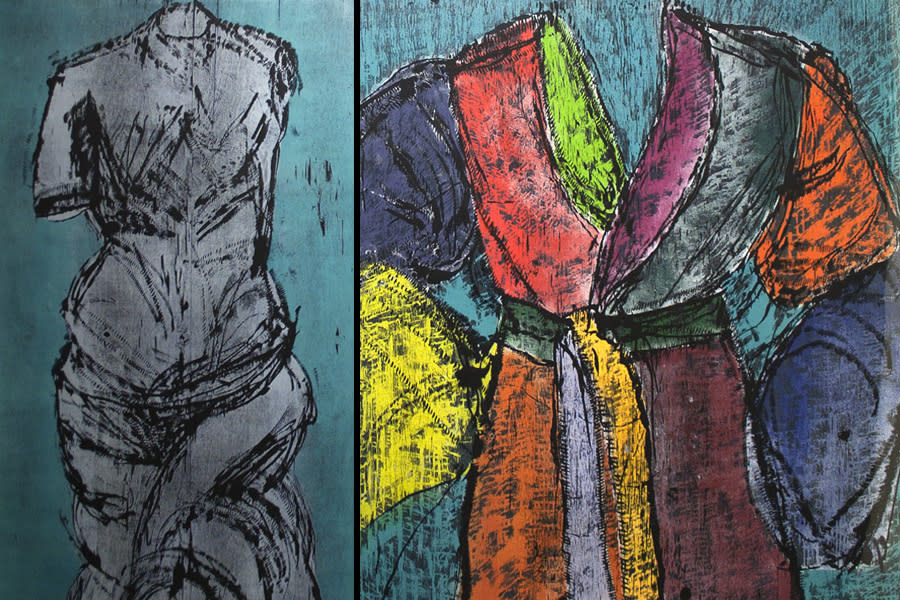
Op art, also known simply as "opart", is a kind of abstract art that makes use optical illusions in order to create a visual effect. This art form is built on a functional relation between the brain (the part of your eye that perceives light) and the retina (the brain). Op-art requires an artist to use ingenuity and math to produce an image that seems like it exists only in the mind. The goal is to create a visual experience that satisfies our need for a sensory illusion.
Op art is an abstract type of art that creates optical illusions.
Op art has a rich and varied history. Op art is an abstract style of art that creates optical illusions with geometric compositions. Artists have long used this technique to create optical effects, but it's also derived from effects that were popular among the Old Masters. The French word trompe l'oeil, which means "to deceive one's eye", is the origin of the term "trompe l’oeil". Op art also uses the center-surround effect, which is a form of illusionary distortion.

It is a kind of science fiction.
Optical art is a form of participatory art, meaning that it requires the presence of the viewer to see it. This creates an equal relationship between the viewer and the creator. This emphasizes interaction between them, rather than the traditional two-way relationship between artists/viewers. Op art makes it appear that there is movement through the use of stark contrasts or abstract shapes. Op art can be very powerful and is particularly useful for futuristic or sci-fi themes.
It is based upon a functional relationship between retinas of the eyes and brain
Optic art uses the functional relationship between the brain and the retina to create art. The brain receives sensory info from the retina. It then relays it to its visual cortex, located at the rear of the brain. The left and right hemispheres process this information differently. It would seem that the left hemisphere would receive information from the left eye, but this is not the truth. Actually, information is received from both the left eye as well as right brain by both hemispheres. Additionally, each hemisphere processes each information differently, which is why certain patterns are more distorted than others.
It requires math ingenuity
Optic art, a type of mathematically-based artwork, uses repetition of form and pattern to fool the eyes. It can alter the viewer's perception of depth and create confusion between foreground/background. This effect is possible only with math and technical skills. It also requires meticulous planning. If the viewer can see the artwork clearly enough, they might be able find hidden images and three-dimensional forms.
This requires technical skills
The art of optical art is a creative field that requires technical skills to create a work of art. Technical artists should be skilled in creating precise and precise artwork. For example, they may design a circle that is exactly two hundred millimeters across and a quarter-inch tall. They need to be sharp in design and able to spot errors in other artists' work.

It is often criticized for being a gimmick.
Critics accuse optical arts of being gimmickry. However, its practice has been going on for centuries. Artists used trompe lait painted effects to show their technical prowess as well as highlight the human desire of trickery. With holograms, however, artists have found new means to create illusions and are exploring its potential as a medium.
FAQ
What is pop culture?
Pop culture is all around. Pop culture is everywhere you go: radio, television, film, music and magazines. It is all around us 24/7. It influences everything from our clothes, food, music, language, politics, and religion. What is pop cultural? Wikipedia states that "Popular culture" refers specifically to ideas and products intended for mass consumption. Many people think that this term applies to television shows, movies, music, fashion, and other forms of entertainment. Pop culture goes beyond entertainment. The term covers everything consumed by the masses. It includes video games, sports and toys, fast food, political campaigns, and many more.
What does pop culture teach us?
Our society today places more importance on material goods than all other things. This is especially true with young people. They spend hours every day looking at screens. They are addicted to video games, movies, and surfing the web. They lose focus of school work because they are constantly distracted by these distractions. This leads to them failing classes.
The world we live in is one where everyone wants the same thing. That means being popular. Popularity depends on money, clothes, and other possessions. Some people do this by doing things that aren’t right.
We are too dependent upon technology. We have all the information we need thanks to technology. Not everything is accurate. False rumors are all over the Internet. These rumors spread fast because people share them on social networking sites. It is easy to share something without verifying its truth.
People have lost the ability of thinking critically. People believe everything they see on the Internet. They trust what they hear on television and in magazines. They stop thinking for them selves. They follow the crowd instead.
We lose control when we rely on other people to tell us what's up. Pop culture teaches us that we can depend on others. This can make us lazy. We don't always see the truth, but it is there.
What are some of the positive aspects of pop music?
Pop culture has some positive aspects. Pop culture is a great source of entertainment. Also, it helps people express their creativity. Pop culture can be used to promote artists' work.
Pop culture's greatest asset is its ability to bring people together. Everyone wants the same show. Everyone listens to the same music. And everyone likes the same movies. Pop culture allows us to connect.
The problem is that not all pop culture is healthy. Some movies glorify violence. Some TV programs mock people with mental disabilities. And some bands encourage fans to do drugs.
What should we do about the negative aspects pop culture?
We need to try to avoid the bad aspects of pop culture. We shouldn't let it influence us. It can cause problems for our health. It can even lead criminality. It can even cause problems in our relationships.
We should also think about whether pop culture is helping or hurting society. Is pop culture promoting good values or negative ones? Are people being influenced to do bad things?
Let's not forget to ask ourselves if our world is fulfilling. Do we enjoy the music that we listen to? The TV shows we watch? What clothes are we wearing?
If we care about our future, we must take responsibility for our actions. The first step is to decide the type of world we want. We can then choose the right pop culture.
How did pop culture develop?
Technology drove the development of popular culture. It evolved as people became mobile. The radio revolutionized mass communication. This allowed for the rise of television and the birth of the internet.
People started using computers at home and were exposed to computer games. These games were originally played on consoles like Sony Playstation 3 or the Nintendo Wii. They are now free to download online. Many people are choosing to play video games over watching TV.
Video games are very much in demand among teenagers and children. You can play alone or with other people via the internet. Games like Call Of Duty and Grand Theft Auto are extremely violent. Parents worry about their children's safety while playing these games. Others find it interesting to see what happens if a character dies.
Music videos are another way pop culture influences youth. They provide information about celebrities and current trends. Many young people love to watch them. Music plays an important part in our lives, there's no question about that!
Music videos are often created by artists who use special effects to enhance their songs. Rappers often use makeup and hair wigs to enhance their looks. Others put themselves through extreme physical demands to show off their bodies. Many singers perform while wearing costumes.
You have so many choices in music today. You can listen any music you wish. This isn't always a good thing. Sometimes music can encourage violence. People become angry when they hear certain lyrics and words. Sometimes they even commit crime.
50 Cent was a victim of this phenomenon recently. The line from his song Get Rich Or Die Trying is "I'm going down a motherfucker / I don’t know why, but I might." Someone heard this song and thought it meant that he was going to kill someone. A man threatened him by calling him. So 50 Cent changed the lyrics. It now says, "I'll shoot one bitch down/ I don’t know why, but I just might."
Popular culture is essential. We must understand its effects on us. If we don’t understand how it affects us, we won’t be able prevent its harmful effects.
What examples of pop culture are there in 2020?
The music industry is changing rapidly, and this year we saw artists such as Billie Eilish, Post Malone, and Travis Scott all reach number 1 on Billboard's Hot 100 chart. This was an incredible feat for any artist.
The same holds true for streaming services. Spotify reported that they streamed over 10 billion hours of audio content last year alone. This is five times more than what Spotify users listened to just five years back!
This has led to a dramatic shift in how media is consumed. The majority of people now spend their time reading content, rather than creating it.
All age groups have easy access to high-quality audio content. Anyone can now record, edit, remix, and publish their music.
You don't have to go to school to learn classical instrumentation in order to play your favorite songs. Simply download an application, add your voice and upload them on YouTube.
You don't have to be a musician, but you can watch others make it. You will find many channels dedicated to creating videos of songs from covers to parodies.
How did pop music become popular?
It was accidental. The accident that someone accidentally knocked down a piano in 1920 caused the first song's creation.
The recording company loved what they heard so they decided to release the single.
This was the first single to be recorded.
Pop music has been the most popular form today of musical entertainment.
What examples are there of pop culture?
Pop Culture refers to the art form of 21st century. Pop Culture encompasses all types of popular entertainment: music, film and TV, video games fashion, advertising, comics, and more. In his 1985 book, Amusing Ourselves Too Death (1985), Neil Postman first coined this term. Pop was a method of mass communication using cheap tricks and formulaic techniques to create an illusion that spontaneity and uniqueness.
He said that people don't experience true joy because they are conditioned to look for media experiences that make them feel better than others. He also argued that cultural expression has contributed to the decline in critical thinking skills among young adults.
Pop culture can also refer to popular culture and consumerism.
Statistics
- Yet a Nielsen study shows they account for 42% of the country's most-watched content on streaming services. courtesy Nielsen (npr.org)
- Less than a decade later, that statistic rose to 90% (Dager, n.d.). (socialsci.libretexts.org)
- For example, the term hater meaning someone who strongly undermines or criticizes others, often due to pathetic jealousy, likely emerged from hip hop culture, such as the term playa hateras, used by influential rapper Biggie Smalls as early as 1995. (simplicable.com)
- According to Kathryn Sorrells (2013, pp. 142-144), there are several ways that we can become informed consumers of popular culture. (socialsci.libretexts.org)
- According to Dictionary.com, popular culture, or low culture as it is sometimes referred to is comprised of the “cultural activities or commercial products reflecting, suited to, or aimed at the tastes of the general masses of people” (7/21/19). (socialsci.libretexts.org)
External Links
How To
What are some pop culture icons?
Americans were obsessed by space travel in 1960s. Star Trek was then the most popular television show.
From 1966-1969, the original series aired at NBC. It starred William Shatner as Captain Kirk, Leonard Nimoy as Mr. Spock, DeForest Kelley as Dr. McCoy, James Doohan as Scotty, George Takei as Sulu, Majel Barrett Roddenberry as Uhura, Nichelle Nichols as Lieutenant Nyota Uhura, Walter Koenig as Pavel Chekov, and Grace Lee Whitney as Yeoman Janice Rand. (Wikipedia)
In 1967, the premiere of the first feature film based upon the series took place. Paramount Pictures released "Star Trek" as the title. Robert Wise directed the movie. It featured an ensemble cast that included William Shatner and Leonard Nimoy as well as DeForest Kelley and James Doohan. (Wikipedia)
In 1968, the second series of the television series began to air. This season was about the crew going back to 1969. (Wikipedia)
In 1971, the third season began airing. This season introduced a new character named Commander Richard A. Morn. He was a Starfleet Officer who was born in 2063 on Earth. (Wikipedia)
During this period, there was also a live-action spinoff called "Star Trek: Planet of the Apes". It aired between 1972 and 1974. (Wikipedia)
The television series premiered its fourth season in 1973. This season introduced two new characters named Lt. Ilia and Ensign Ro Laren. Marina Sirtis played them both. (Wikipedia)
In 1975, the fifth season of the television series premiered. This was the last season that aired before the franchise went into hiatus. (Wikipedia)
After the series was cancelled, many attempts were made to revive them. Some of them included the 1977 pilot episode "Where No Man Has Gone Before" which was not able to find a studio or network partner. (Wikipedia)
Star Trek: New Voyages was also animated in 1998. It lasted for only 13 episodes. (Wikipedia).
In 2009, the sixth season of the television series returned after a seven-year hiatus. It was titled "Enterprise". It ran for five seasons before it ended in 2013. (Wikipedia)
Three feature films were also made during this time. The first film was released in 1979. It was called Star Trek: The Motion Picture. It was directed by Nicholas Meyer. The film starred William Shatner, James Doohan, Leonard Nimoy, Walter Koenig, George Takei, Majel Barrett Roddy, and Ricardo Montalban. (Wikipedia)
The following two movies were released respectively in 1982 and 1987. They were "Star Trek II - The Wrath of Khan", and "Star Trek III - The Search For Spock". Both of these movies were directed by Nicholas Meyer. (Wikipedia)
The seventh season of the TV series aired in 2001. It was called "Encounter at Farpoint". It was the debut episode of the show's era without guest stars. (Wikipedia)
2005 saw the airing of the final episode. It was titled "All Good Things ...".." Ronald D. Moore wrote it. David Livingston directed it. (Wikipedia.)
In 2008, a brand new Star Trek TV show premiered. It was called "Trek Nation". It's currently being aired by CBS. (Wikipedia)"Trek Nation" is about a group of people from different walks of life who get together to form their version of the United Federation of Planets. Their goal? To help other planets find peace. (Wikipedia). "Trek Nation", which is a concept showing how diverse people can unite and create good, is very intriguing. (YouTube Video)
It is a good idea to read books about Star Trek's timeline. Gary Wolfe's "Star Trek Chronology", is a good place to start. You can find many other books online.